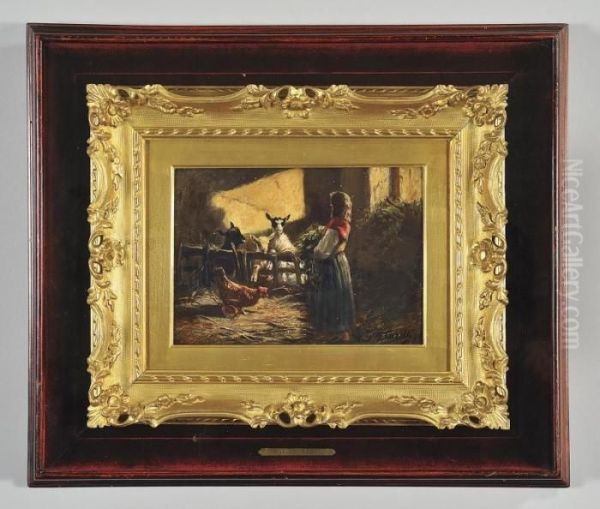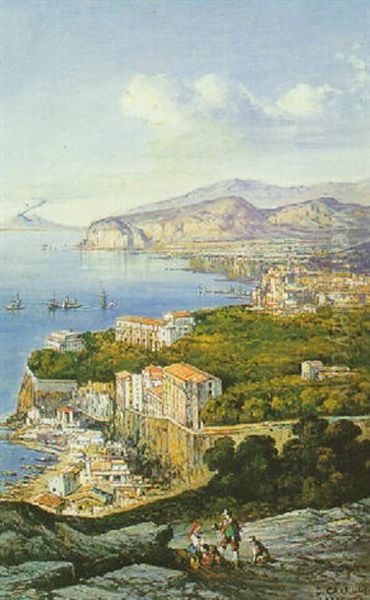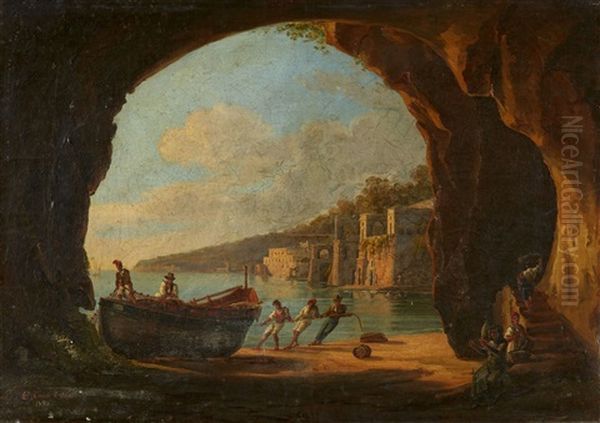
Consalvo Carelli, born in Naples in 1818 and passing away in the same city in 1900, stands as a significant figure in the landscape of 19th-century Italian art. A prominent member of the celebrated School of Posillipo, Carelli dedicated his long career to capturing the vibrant beauty of the Italian landscape, particularly the environs of his native Naples. He hailed from a distinguished artistic dynasty, inheriting a passion for painting that he would cultivate and refine throughout his life, leaving behind a legacy of works cherished for their sensitivity, naturalism, and technical brilliance.
Early Life and Artistic Formation
Born into a family with deep artistic roots originating from Puglia, Consalvo Carelli's path seemed destined for the arts. His father was the renowned landscape painter Raffaele Carelli, a respected artist in his own right, whose influence undoubtedly shaped Consalvo's early development. Alongside his brothers, notably Gabriele Carelli who would also become a painter, Consalvo received initial guidance within the family circle. His formal training was further enriched under the tutelage of the British painter William Leech, from whom he likely honed his skills, particularly in the demanding medium of watercolor, a technique he would master with exceptional finesse.
The pursuit of artistic knowledge led Consalvo, accompanied by his brother, to Rome in 1837. This period was crucial for broadening his horizons. In the Eternal City, he immersed himself in the study of classical painting traditions and absorbed the lessons of 17th-century landscape masters, whose approaches to composition and light would inform his own developing style. Even before this formative trip, Carelli had begun to make his mark. As early as 1830, he exhibited a double-sided oil painting at the Bourbon Exhibition in Naples, earning a silver medal. This early recognition was followed by a gold medal at the same exhibition in 1835, signaling the arrival of a promising young talent.
Embracing Nature: The School of Posillipo

Consalvo Carelli became a central figure in the School of Posillipo, a movement that fundamentally reshaped Neapolitan landscape painting in the 19th century. This group of artists reacted against the perceived rigidity and Neoclassical constraints of the official Naples Academy of Fine Arts. Instead of idealized or purely historical landscapes, they championed a more direct, truthful engagement with nature. Inspired initially by foreign artists like the Dutch painter Anton Sminck van Pitloo, who settled in Naples, the Posillipo painters sought to capture the unique light, atmosphere, and topography of their surroundings.
Key figures associated with this school, alongside Carelli, include Giacinto Gigante, Achille Vianelli, Teodoro Duclère, and Salvatore Fergola. They often worked outdoors (en plein air), creating sketches and studies directly from life. Their preferred subjects were the iconic vistas readily available to them: the breathtaking Bay of Naples, the imposing silhouette of Mount Vesuvius, the ancient ruins of Pompeii, and the picturesque towns along the Sorrento and Amalfi coasts. Carelli fully embraced this philosophy, rejecting academic formulas in favour of inspiration drawn directly from the natural world he observed so keenly. His work embodies the Posillipo spirit: a commitment to realism infused with a romantic appreciation for the beauty of the local landscape.
Artistic Style and Signature Works
Consalvo Carelli's artistic output is dominated by landscape painting, though his repertoire also included figure studies, animal paintings, and still lifes, showcasing a breadth of interest. He possessed a particular affinity for the countryside of the Lazio region and, most famously, the areas surrounding Naples. His style represents a harmonious blend of Romanticism and Realism. There is a clear romantic sensibility in his choice of picturesque views and his ability to evoke mood, yet this is always grounded in careful, realistic observation.
He was celebrated for his technical proficiency in both oil and watercolor. His watercolors, in particular, were highly sought after, admired by European nobility for their delicate execution and vibrant luminosity. Across his chosen media, Carelli demonstrated a remarkable ability to capture the effects of light and shadow, rendering the clarity of the Mediterranean sun and the subtle shifts in atmosphere with great accuracy. His paintings often convey a sense of immediacy and "freshness," bringing the Neapolitan scenery to life.

Among his notable works are landscapes that capture the essence of the region, such as La Sorrentina (evoking the beauty of the Sorrento peninsula or bay) and views titled Cava dei Tirreni (likely depicting the town or valley near Salerno, perhaps focusing on local life like fishermen). His oil painting Pastori nella baia di Napoli (Shepherds in the Bay of Naples) exemplifies his skill in integrating figures naturally into the expansive coastal scenery. Another recorded work, Vista della Cava dei Tirini, further underscores his interest in this location. Works like Contadinella (Country Girl) highlight his engagement with rural themes and figures. He is also known to have experimented with techniques, sometimes painting on joined wood panels.
A Flourishing Career and Esteemed Patronage
By the mid-1840s, Consalvo Carelli, together with his brother Gabriele, established a studio in the fashionable Chiaia district of Naples. This marked a period of growing professional maturity and recognition within the local art scene. His reputation extended beyond Naples; he spent time developing his career in Paris and his works gained appreciation internationally. Carelli's talent attracted the attention and support of influential patrons. From his youth, he enjoyed the protection of noble families, including the Giorgio and Meirrecate families of Florence, and cultivated friendships with figures like Sergio Nassa of Monte San Nicola.
His connections reached the highest levels of society. Significantly, two of his landscape paintings were acquired by King Ferdinand II of the Two Sicilies, and these works remain preserved in the Royal Palace of Naples, a testament to his royal favour. Later in his career, his esteem was such that he was appointed as a drawing and watercolor teacher to Queen Margherita of Savoy, the wife of King Umberto I of Italy. This royal appointment further solidified his status. The consistent demand for his work, especially his watercolors, among European aristocrats and collectors underscored his widespread appeal throughout his long career. His paintings frequently appeared in auctions, indicating their value and desirability in the art market of the time and subsequently.
An Artistic Family: The Carelli Dynasty
The story of Consalvo Carelli is inextricably linked to his family's artistic legacy. He was not an isolated talent but part of a multi-generational dynasty of painters. His father, Raffaele Carelli (1795-1864), was a foundational figure whose own success as a landscape painter, influenced by Neoclassicism and Romanticism and recognized in both Italy and Paris, provided a powerful example and likely opened doors for his sons. Consalvo built upon this foundation, adapting the family tradition towards the more naturalistic approach of the Posillipo school.

He maintained a close working relationship with his brother, Gabriele Carelli (1820-1900), sharing a studio and likely collaborating or influencing each other's work. Gabriele himself achieved considerable success, continuing to be active after Consalvo's death and notably contributing works to the British Royal Collection. The artistic lineage continued with Consalvo's son, Giuseppe Carelli (1858-1921), who also became a painter, carrying the family's artistic pursuits into the early 20th century. Furthermore, Consalvo's social connections within the cultural sphere are suggested by his friendship with the father of Massimo d'Azeglio, another prominent 19th-century Italian figure (painter, novelist, and politician), indicating his integration into the broader artistic and intellectual circles of his time.
Legacy and Context in Italian Art
Consalvo Carelli holds a secure place in the history of 19th-century Italian art, particularly as a leading exponent of the School of Posillipo. His dedication to landscape painting, combined with his technical skill and sensitive observation, contributed significantly to the movement's success and enduring appeal. His work, balancing Romantic feeling with Realist detail, offered a compelling vision of the Italian landscape that resonated with contemporary audiences and continues to attract admiration.
His approach can be contextualized within the broader Italian art scene. While Carelli and the Posillipo school focused on the light and scenery of Naples, other regional movements were developing distinct forms of Realism, such as the Macchiaioli in Tuscany, led by artists like Giovanni Fattori and Telemaco Signorini, known for their revolutionary use of 'macchie' (patches or spots) of colour. Carelli's style remained distinct, rooted in the Neapolitan tradition but open to influences, including the British watercolor tradition transmitted through his teacher William Leech, and perhaps finding resonance with the atmospheric concerns of British masters like J.M.W. Turner. His study of earlier masters like Claude Lorrain also provided a historical depth to his landscape vision. He stands apart from the more strictly academic painters associated with institutions like the Naples Academy, such as Domenico Morelli, although even artists like Filippo Palizzi, initially academic, also moved towards greater realism.
The enduring presence of Carelli's works in collections and their continued appearance at auction houses attest to his lasting significance. He successfully captured the unique allure of Naples and its surroundings, creating images that defined the region for many viewers, both within Italy and abroad.
Conclusion
Consalvo Carelli was a gifted and dedicated artist whose life spanned a transformative period in Italian art. As a key member of the School of Posillipo and the scion of an artistic dynasty, he played a vital role in the development of 19th-century landscape painting. Through his masterful oils and watercolors, he captured the light, atmosphere, and picturesque beauty of Naples and the Italian countryside with a blend of romantic charm and realistic fidelity. His legacy endures in his luminous depictions of nature, works that continue to be cherished by collectors and art enthusiasts for their technical brilliance and evocative power.